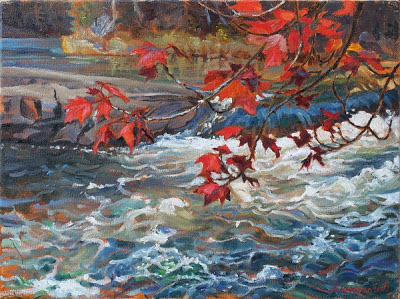Dyers Polypore (oil on canvas 12 x 16 in.) Sold
20 August finds me painting this magnificent polypore fungus at the Open House of our Caledonia Gorge PNA Bio-blitz. Specialists, students, and volunteers are all at our tables in the "Lab" (the barn-like hunting headquarters of the Shepody Pheasant Preserve) and visitors watch Science (and art) being done.
This fungus, 30 cm across, was found on August 14 beside the Canada Creek trail beneath a Spruce beside the rocky creek, near where I
painted the "Burly Fir". It is Phaeolus schweinitzii, causing rot in the roots and bases of conifers. Unlike shelf fungi which flare from the sides of trees, this polypore grows on a short stem or stipe, from the ground beside the tree that it feeds on. Valued for its rich colours when used for dyeing, it is called Dyer's Polypore. Also called Velvet-top Fungus, its velvety upper surface becomes wonderfully convoluted as it grows.
Another name for it is Dyer's Mazegill. When it was brought into the lab we all admired the maze-like pattern of pores in its underside and thought it would make an interesting spore print. I underpainted a canvas for this painting and sequestered it over the edge of my canvas, safe from drafts beneath a plastic tote bin covered in damp cloths to keep cool, and checked for its spore print each morning, but there was no pattern of dropped spores on the canvas, so I decided to paint it anyway, floating alone on the shadowy canvas.
Both the specimen and the painting are going to the New Brunswick Museum.
This fungus, 30 cm across, was found on August 14 beside the Canada Creek trail beneath a Spruce beside the rocky creek, near where I
painted the "Burly Fir". It is Phaeolus schweinitzii, causing rot in the roots and bases of conifers. Unlike shelf fungi which flare from the sides of trees, this polypore grows on a short stem or stipe, from the ground beside the tree that it feeds on. Valued for its rich colours when used for dyeing, it is called Dyer's Polypore. Also called Velvet-top Fungus, its velvety upper surface becomes wonderfully convoluted as it grows.
Another name for it is Dyer's Mazegill. When it was brought into the lab we all admired the maze-like pattern of pores in its underside and thought it would make an interesting spore print. I underpainted a canvas for this painting and sequestered it over the edge of my canvas, safe from drafts beneath a plastic tote bin covered in damp cloths to keep cool, and checked for its spore print each morning, but there was no pattern of dropped spores on the canvas, so I decided to paint it anyway, floating alone on the shadowy canvas.
Both the specimen and the painting are going to the New Brunswick Museum.




Comments
Post a Comment
What do you think of this painting, and what do you know about the subject that I have painted?